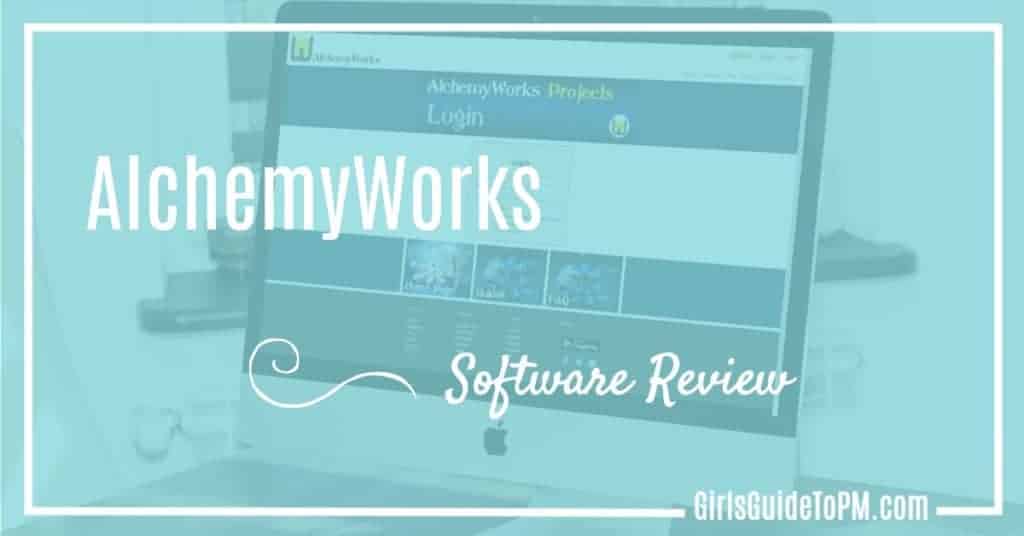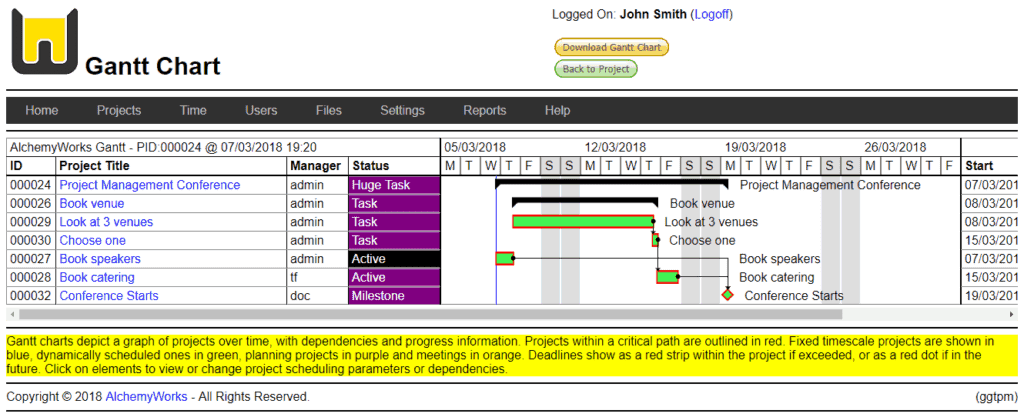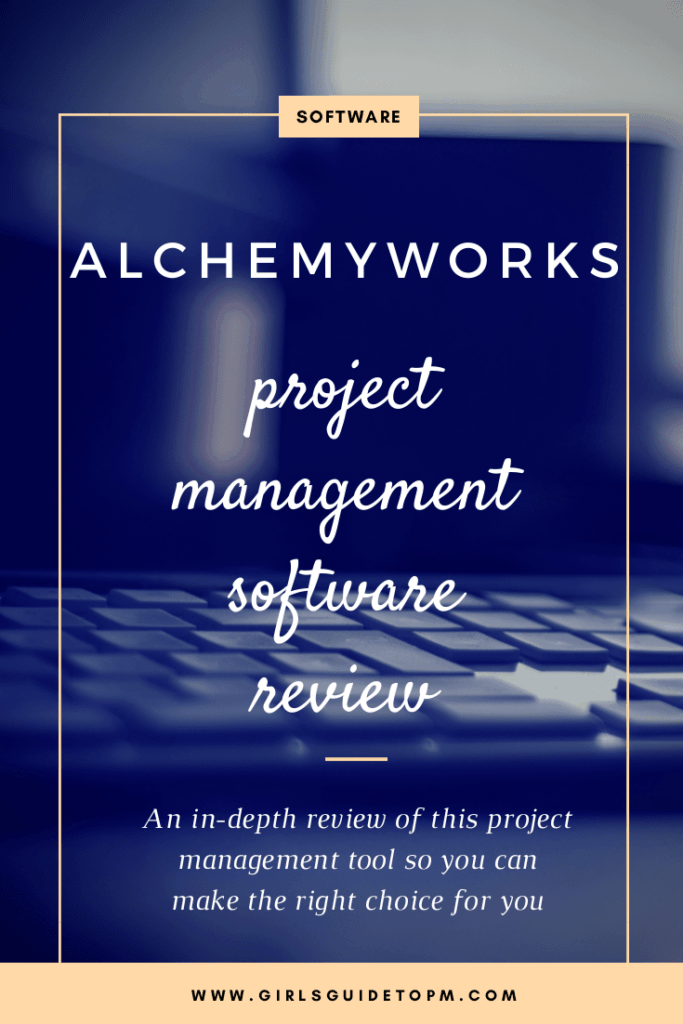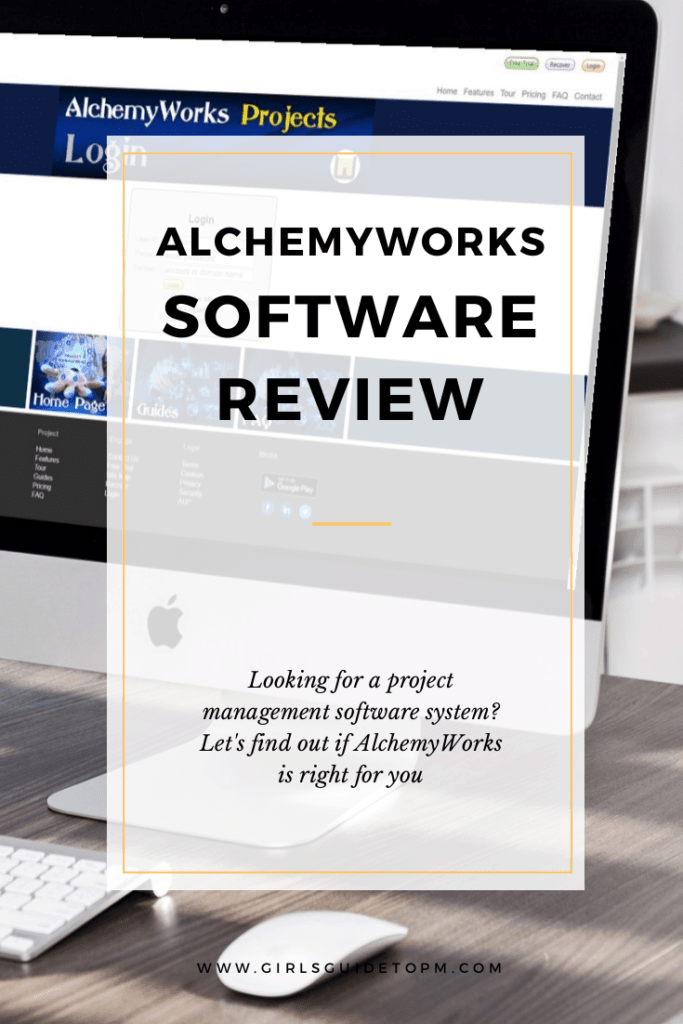AlchemyWorks: Software Review
Read our review guidelines.
General information
Name: AlchemyWorks
Vendor: AlchemyWorks Ltd
Hosting options: Web only. There’s also an android app available.
Languages: English comes as standard and you can add terminology in your own language. However, system prompts and contextual help are only available in English.
Cost: Free 30-day trial, then plans from $4.99 per user per month for basic features, with document storage extra.
This article was sponsored by AlchemyWorks but all opinions are my own. Article updated 13 March 2018 with additional information about the release of the Gantt chart functionality.
First Impressions
The first time I looked at AlchemyWorks I thought… well, let’s just say it wasn’t the most stylish of tools I’ve used. The dashboard you saw on that first log in also had quite an old-fashioned style.
Then I found out that you can actually configure what it looks like by browser. I had a play around and found a style I could live with – the mobile browser versions feel more modern and ‘app like’ than the desktop versions, but it’s highly configurable so you do have the ability to amend the look and feel to work for you.
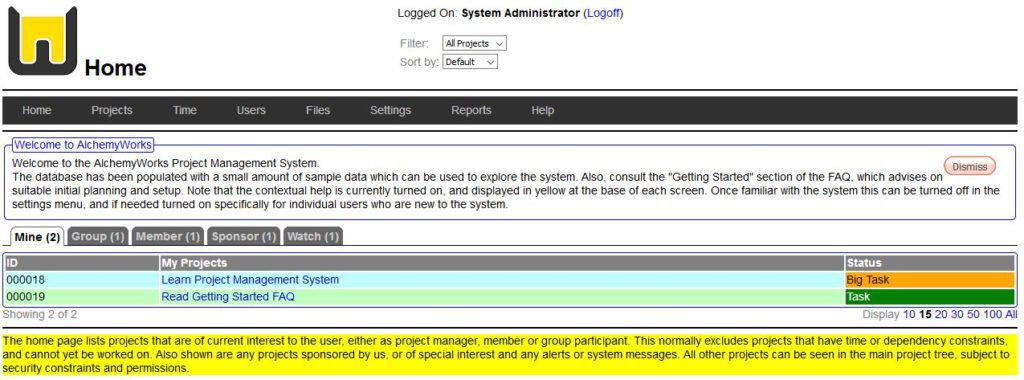
Creating a Project in AlchemyWorks
Projects are organised in directories. It’s easy to set up a project – click New and then give it a name. That opens the screen you’ll spend most of your time in: the project dashboard.
You’ll want to update the General tab here with information about the project. Remember to click Update Project before you navigate to any of the other tabs or you’ll lose the changes you have made.
Then you can work through the other tabs, adding in workers and documents as necessary.
The Events tab lets users add activity that they have worked on, which feeds into time used, automatically takes time off existing estimates to reduce them and accumulates financial information for the project. You can use the built-in time to track time per activity.
It ends up looking like a list of all the activities that have happened on the project, so it can appear like an audit trail of who has changed what. The activities entered also show up in the diary view and on the project timelines so you can monitor progress.
Adding Tasks
The interface to add tasks doesn’t feel intuitive if you are used to Gantt-based scheduling. Adding a task is effectively adding a sub-project in the tree hierarchy. You can then add sub-projects to that task too. You can see the hierarchy for the project from the main project tree, which is helpful, and then drill down into the tasks.
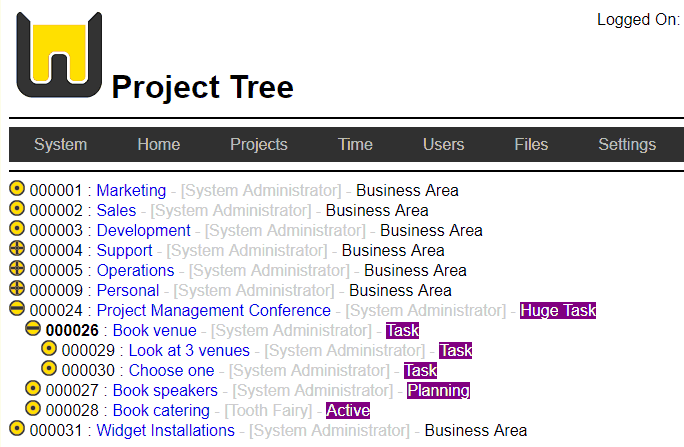
The Timeline view only works for one ‘layer’ of the project hierarchy at a time, so you can’t get a total picture on one screen, only the rolled up version. I think for repeated work like client installs of widgets (which is the example in the help files) then it probably wouldn’t matter much, especially as there are other views that provide the same information, like diary view.
One thing you need to take into account though is that resources cascade down into new sub-projects, but they don’t roll up. I added resources to tasks (sub-projects) and that information is not passed back up the hierarchy. When I look at my main project, I only see the resources who have been assigned to that. Remember to add your resources at the top level!

Templates
AlchemyWorks has the option to save a project as a template. That will save you lots of time when you come to start a new project. It’s always helpful to have built in shortcuts so this is a nice feature.
There are also options built into the interface that streamline what users see. For example, if you create a project with the status of Huge Task, you can see more project management options like the risk tracker and financial information.
Scheduling
AlchemyWorks talks about dynamic scheduling, and it will organise tasks for you in order if the projects are active or you allocate them the status of Planning. Tasks are scheduled by priority, subject to dependencies and time constraints placed on the project. You have full flexibility to define status codes which drive other behaviours, if you wish.
It also has a couple of useful functions for scheduling, namely a vacation planner (excellent feature – it’s always annoying to have to block out working time or add someone’s holidays in as a task) and a holiday calendar, where you can add public holidays and office closures. You can also run a vacation report, which is handy to see who is going to be out when.
It has some intelligent scheduling help as well: if your users have time slots blocked out to show their availability, and there are also time slots defined for when the project has to happen, and there’s no overlap between these, then you can’t get any work done and the project shows you an alert message.
The website lists Gantt charts as one of the features of the tool, but from what I could tell during my software review, you can’t edit in Gantt mode – it’s just a way of displaying task information that has been added elsewhere.

Gantt Charts
The Gantt chart view functionality was added in March 2018, so when I looked at the tool again I was pleased to see the development team are adding new features.
The Gantt view is accessible from the project timeline via a button on the right hand side of the screen (or top on mobile). This takes you to a screen that allows you to set a few parameters for the chart, like types of project to include, whether to also pull in any projects linked by a dependency outside of the current tree. You can also filter to exclude projects based on time or project manager.
The defaults should be fine in most cases, if all you want to do is click through get the information in chart view. Where you’ve got lots of activities within a similar timeframe you can expand the horizontal axis to give you more space to read the info.
Critical path work shows with a red outline. Milestones are shown as diamonds, as you would expect. I still find the terminology confusing: milestones are created as projects with no child projects and no remain/complete work defined. Project managers wouldn’t call this a project — it’s just a task with the duration of zero, which is the standard definition of a milestone.
Deadlines are indicated either as red dots if in the future, or a red bar within a project if they will or have been exceeded. It’s good that they flag up visually. Hovering over items in the Gantt view shows you extra information and you can click through for more info.
You can also print charts or download them as an image file. I think this is interesting because they download as .svg files which means you can edit them in Inkscape. That’s the graphics package I use to make some of the more complicated images I need for my blog and my business, and I would never have considered using it to create or edit a Gantt chart. I haven’t tried this functionality, but it feels good that it’s there!
Risk Management
Once you’ve got the risk management switched on, the risk log is really very good. I like how it allows you to estimate the likelihood and impact before and after your mitigating actions are defined, which allows you to work out and show residual risk.
You can then summarise the risks on the risk register report. This shows you all the risks, their likelihood, impact and an assessment of priority based on the data you’ve entered. It’s not the prettiest of reports, but it’s functional, and the project IDs listed against each risk let you click back through to the rest of the project information.
Risk management (like
Collaboration Features
You can amend what features show for each project type by creating status codes that align to what you want the users to see. For example, you could limit showing the chat features to certain types of project – while it’s still there it’s “hidden” so you can get your team to focus on the features you want them to use and not all the functionality.
NB: Chat isn’t a feature available on all plans, so if this is an important piece of functionality for you, make sure you choose a plan where it is included.
You can also attach files to a project.
When it comes to sharing with other people, there are features in AlchemyWorks that lock down what you can see, so that’s helpful when you have confidential projects on the go. There are defined levels of security clearance that also affect how strong your password needs to be for logging in.
Agile Projects
AlchemyWorks was updated in March 2018 to include support for Scrum and sprints. On the project schedule tab you can toggle a project to be part of a sprint or not, and current sprint projects will show up in a new tab on the user home page (if there are any). Scrum is now a status display type that shows two new tabs within a project, one for current sprint projects, and another for backlog of other active sub-projects.
Sprint-marked projects also show an asterisk in the status field for lists.
Reporting
There are a number of reports available. During my review of AlchemyWorks I didn’t find a way to create my own reports, but what comes out of the box is perfectly adequate for what I wanted to do.
The user utilisation report is handy. It shows you the next availability for your team members, so you can see when you’ll be able to take on your next client project. If I ran a small building firm, then this kind of report that would allow me to tell prospective clients when I could have someone round to start work on their loft conversion.
In summary…
AlchemyWorks has its place. I can see many uses for this tool, especially in environments where there are lots of repetitive projects and client work. I can see it working in small businesses where there might be many clients, many projects, but they don’t need to record a lot of depth for tasks, or have much cause for ‘professional’ project risk management.
I think that the biggest limitation is the way the tool manages tasks, which is an unusual way of creating a work hierarchy. I think this would be difficult to work with if it went to any depth, although the new Kanban features will certainly make this easier to manager.
You need to spend some time tweaking the interface as the out of the box one is serviceable, but might benefit from being styled the way you like it.
The more you use this product, the more you’d find that there are hidden gems in the functionality, like the vacation reporting. The more you got used to working with Status distinctions, the more use you could find for it – for example, you could easily manage your everyday To Do list if you had a status set up appropriately.
Right to Reply
We got in touch with the team at AlchemyWorks to share this review with them and to learn about the new features that they are adding. Here’s what they said:
- “There is now a kanban module under the projects directory, where boards can be defined across a range of project status codes (which would probably be a workflow).
- The project tree (from the main projects menu) now has a better browsing mechanism than the previous table interface. I’ll also add in a few filters and options in the next development round.”
It’s so good to see a tool that is constantly updated and that is taking on board user feedback to make enhancements. It makes you feel supported to know that the team is really listening and actively working on improving the product, and if the functionality comes at the same speed as it has done in the last few months, we’ll see this tool improve even more in the year to come.

